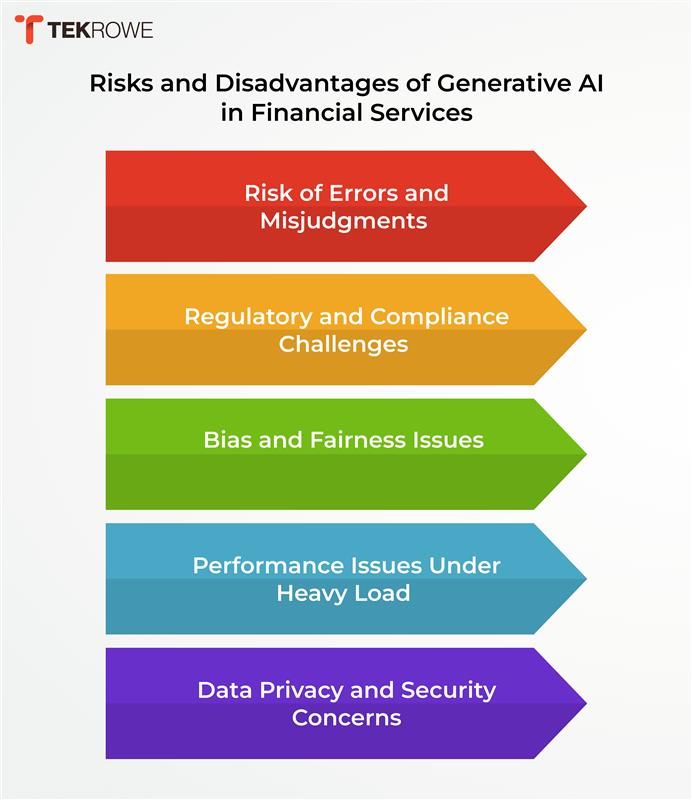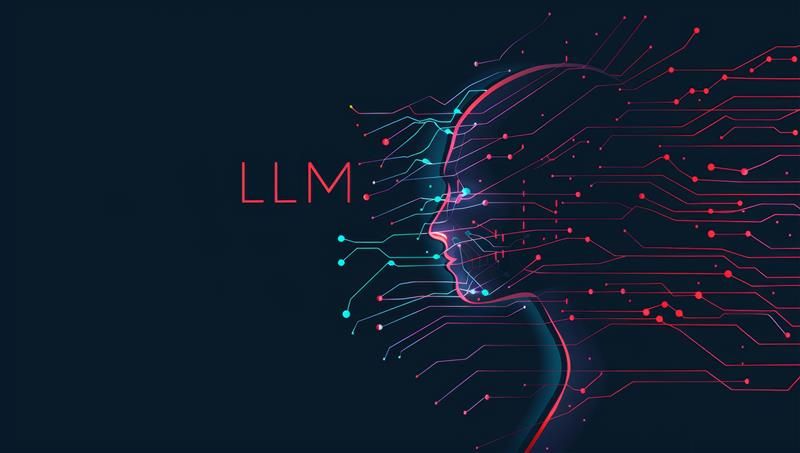Imagine a world where financial institutions could predict market trends with near-perfect accuracy, personalize services for every customer, and streamline complex operations without human error. This isn't a futuristic fantasy—generative AI use cases in financial services are making this a reality today. With generative AI, financial firms are not only enhancing their operational efficiency but also transforming how they engage with clients, manage risks, and drive innovation. In the past, traditional artificial intelligence and machine learning primarily focused on making predictions and classifying data based on existing inputs. However, with the advent of generative AI services, we can now create entirely new content by analyzing behavioral patterns in the existing data.
This advanced technology allows for the generation of content across various formats, including text, images, code, and music, making it highly versatile for numerous applications. According to statistics reported by Market Research, the market valuation of AI in financial services is estimated at $1.85 billion in 2023 and is projected to grow to $9.48 billion by 2032. In this blog, we’ll explore the key generative AI use cases in financial services that are revolutionizing the industry, offering unparalleled benefits across various sectors.
An Overview of Generative AI in Finance and Banking
Generative AI is transforming the finance and banking sectors by enhancing how institutions handle data, make decisions, and engage with customers. Unlike traditional AI, which focuses on analyzing and predicting outcomes based on historical data, generative AI can create new data and insights, offering innovative solutions across various financial processes. Its applications range from fraud detection and risk management to personalized financial services and automated customer support. Generative AI helps financial institutions streamline operations by automating complex tasks like regulatory compliance, document generation, and customer service interactions. It also enables the creation of customized investment portfolios and savings plans, improving customer experiences and boosting loyalty. As financial services become more data-driven, generative AI in finance and banking is set to play a crucial role in improving efficiency, security, and innovation in the industry.
Driving Factors of Generative AI in Finance
Generative AI is rapidly transforming the finance industry, driven by several critical factors that enhance its adoption and effectiveness. As the financial landscape becomes increasingly complex, generative AI in finance is emerging as a key tool for improving efficiency, accuracy, and customer satisfaction. Here are the primary driving forces behind its rise.
1. Advancement in Machine Learning
One of the leading drivers of generative AI in finance is the rapid advancement of machine learning (ML) algorithms. Over the past few years, ML models have become more sophisticated and capable of handling complex financial data. These advancements allow generative AI to not only analyze data but also generate new insights, predict trends, and even create financial models. Generative AI leverages these powerful ML algorithms to enhance tasks such as fraud detection, risk management, and personalized services. As ML technology continues to evolve, it is expected to unlock even greater potential in automating financial processes and improving decision-making accuracy.
2. Increase in Data Volume
The massive growth in data generated by financial transactions, customer behavior, and market activities is another key factor driving the adoption of generative AI in finance. Financial institutions now have access to vast amounts of structured and unstructured data, from transaction histories to social media trends and regulatory updates. Generative AI thrives in data-rich environments, using this abundance of information to deliver precise insights, generate tailored financial recommendations, and forecast market trends. As data volume continues to grow, generative AI’s ability to process and analyze this data efficiently makes it an essential tool for modern finance.
3. Financial Cost Reduction
Cost reduction is a significant motivator for the integration of generative AI in financial services. By automating tasks such as document processing, customer service, compliance checks, and fraud detection, generative AI reduces the reliance on manual labor, which in turn lowers operational costs. AI-driven automation also minimizes errors and the need for repeat processes, further enhancing cost efficiency. Moreover, by improving risk management and fraud detection, generative AI helps prevent financial losses, which adds to the overall reduction in expenses. Financial institutions are increasingly looking to AI as a means of cutting costs while improving the quality and speed of their services.
Top 10 Best Generative AI Use Cases in Finance and Banking
Generative AI is making significant inroads into the finance and banking sectors, offering transformative solutions that enhance efficiency, security, and customer satisfaction. From automating processes to providing personalized financial services, the applications of generative AI in finance are extensive. Here are the top 10 generative AI use cases in finance and banking, showcasing how this technology is reshaping the industry.
1. Fraud Detection and Prevention
One of the most critical generative AI use cases in finance is in the area of fraud detection and prevention. Financial fraud costs the industry billions of dollars every year, and traditional methods often struggle to detect sophisticated attacks. Generative AI can model complex fraud scenarios by analyzing historical data, identifying patterns, and simulating potential fraud tactics. This predictive capability helps financial institutions stay ahead of fraudsters by detecting anomalies in real-time, reducing false positives, and preventing fraudulent activities before they escalate. For instance, AI can monitor transaction patterns and instantly alert institutions of unusual activities that may indicate fraud, such as identity theft or unauthorized transactions.
2. Personalized Financial Services
Generative AI is transforming how banks and financial institutions deliver personalized services to customers. By analyzing vast amounts of customer data, including transaction histories, spending habits, and financial goals, AI can generate highly tailored financial products. Whether it's recommending personalized investment portfolios, customizing loan offers, or designing tailored savings plans, AI enables financial institutions to offer services that are directly aligned with individual needs. This personalization not only improves customer satisfaction but also boosts retention rates and increases customer loyalty. Studies show that personalized services can increase customer engagement by up to 30%.
3. Automating Customer Support with AI Chatbots
Another highly effective generative AI use case in banking is automating customer support with AI-powered chatbots and virtual assistants. These AI systems can handle routine customer inquiries, assist with account management, provide loan information, and even offer financial advice in real-time. By integrating natural language processing (NLP), these chatbots can engage in meaningful conversations with customers, providing fast and accurate responses without the need for human intervention. For example, virtual assistants like Bank of America’s “Erica” have significantly improved customer service, handling millions of inquiries every month. This reduces the workload of human agents, allowing them to focus on more complex tasks while providing round-the-clock support to customers.
4. Risk Management and Credit Scoring
In finance, managing risk and assessing creditworthiness are key components of maintaining financial stability. Generative AI models can analyze vast datasets, including credit histories, transaction patterns, and economic indicators, to predict risk factors and assess credit scores more accurately than traditional methods. For instance, AI can evaluate a customer’s credit risk by analyzing non-traditional data points, such as social media behavior or spending habits, offering a more comprehensive assessment. This allows institutions to approve or deny loans more confidently, minimize defaults, and tailor lending strategies to individual risk profiles.
5. Financial Forecasting and Market Prediction
Generative AI in banking is also revolutionizing financial forecasting and market predictions. By analyzing historical data, economic trends, and market indicators, AI can generate models that predict future market behavior with high accuracy. Financial institutions can use these predictions to optimize investment strategies, identify potential risks, and make informed business decisions. For example, AI can simulate various market scenarios, helping investors anticipate market downturns or growth trends. According to McKinsey, AI-driven forecasting models have improved accuracy by up to 10% compared to traditional forecasting methods.
6. Enhancing Regulatory Compliance
Compliance with regulatory requirements is a time-consuming and costly challenge for financial institutions. Generative AI can automate many aspects of regulatory compliance by analyzing large volumes of legal and transactional data. AI models can generate compliance reports, monitor transactions for regulatory breaches, and predict future compliance risks. For instance, generative AI can review thousands of contracts or legal documents to ensure they meet regulatory standards. This not only reduces the risk of fines or legal issues but also cuts down on the resources needed to manage compliance manually. The automation of compliance processes is crucial, especially as regulations continue to evolve.
7. Document Processing and Automation
Document processing is a tedious but essential part of financial operations, from loan applications to contract generation. Generative AI can automate these processes, creating, reviewing, and managing large volumes of documents in a fraction of the time it takes humans to do the same. AI can extract data from unstructured sources, like PDFs or scanned documents, and use it to generate reports or legal agreements. For example, AI can process mortgage applications, extract key information, and auto-generate loan documents, reducing the time it takes to approve a loan. This leads to faster processing times, fewer errors, and improved operational efficiency.
8. Investment and Portfolio Management
Generative AI is transforming investment and wealth management by providing advisors and investors with advanced tools to optimize portfolios. AI can analyze market trends, financial data, and economic indicators to generate strategies tailored to an investor's risk tolerance and financial goals. For example, AI can simulate various investment scenarios, helping advisors recommend the best asset allocation for a client's portfolio. AI can also optimize portfolios in real-time, automatically adjusting to market changes and improving returns. The integration of AI in investment platforms is expected to manage over $2 trillion in assets by 2025, according to PwC.
9. Loan Approval and Credit Underwriting
Generative AI use cases in finance extend to the automation of loan approval and credit underwriting processes. Traditional underwriting methods are often time-consuming and rely heavily on manual data analysis. AI can streamline these processes by analyzing customer data in real-time, evaluating creditworthiness, and automatically approving or rejecting loans based on predefined criteria. For example, generative AI can analyze a wide range of factors, such as employment history, spending habits, and credit scores, to generate an accurate risk profile. This allows financial institutions to approve loans faster while minimizing the risk of defaults.
10. Fraudulent Transaction Detection and AML Compliance
Generative AI is crucial in detecting fraudulent transactions and ensuring anti-money laundering (AML) compliance. Financial institutions must continuously monitor transactions to detect suspicious behavior, but traditional systems often flag too many false positives. Generative AI can significantly reduce this by creating models that predict and simulate potentially fraudulent activities, leading to more accurate detection and fewer false alerts. Moreover, AI enhances AML compliance by analyzing customer data and transactions to identify patterns associated with money laundering. This helps institutions comply with regulations while improving overall security.
Benefits of Generative AI in Financial Services
Generative AI is revolutionizing the financial services industry, offering powerful tools that enhance efficiency, improve customer experiences, and drive innovation. Its ability to generate new insights, automate processes, and personalize services makes it a valuable asset for financial institutions aiming to stay competitive in a rapidly changing landscape. Here are the key benefits of generative AI in financial services:
1. Enhanced Customer Personalization
Generative AI allows financial institutions to offer highly personalized services by analyzing customer data, such as spending habits, investment preferences, and financial goals. This leads to tailored financial products, from customized savings plans to personalized investment portfolios. By delivering targeted services, financial firms can increase customer satisfaction and loyalty. Studies have shown that personalization can boost customer engagement by up to 30%.
2. Improved Fraud Detection and Risk Management
Financial fraud is a major concern, and generative AI offers enhanced tools for fraud detection and risk management. AI models can analyze large volumes of transaction data to identify unusual patterns that may indicate fraudulent activity. By generating simulations of potential fraud scenarios, AI helps institutions predict and prevent fraudulent actions before they escalate. This real-time fraud detection improves security and reduces financial losses due to fraud.
3. Streamlined Compliance and Regulatory Adherence
Generative AI helps financial institutions manage complex regulatory requirements by automating compliance tasks. AI models can monitor transactions for regulatory breaches, generate compliance reports, and ensure that processes adhere to industry regulations. This reduces the risk of fines and penalties due to non-compliance while also lowering the costs associated with manual compliance checks.
4. Automation of Repetitive Tasks
One of the significant benefits of generative AI in financial services is the automation of time-consuming tasks like document processing, data analysis, and customer onboarding. AI can generate and process financial documents such as contracts, reports, and loan applications faster and with greater accuracy than human workers. This leads to reduced operational costs, faster transaction processing, and improved overall efficiency.
5. Advanced Financial Forecasting
Generative AI enhances financial forecasting by analyzing historical data, market trends, and economic indicators to generate accurate predictions. This helps financial institutions make more informed decisions regarding investments, risk management, and resource allocation. AI-driven forecasting models offer higher accuracy than traditional methods, enabling businesses to better navigate market fluctuations and optimize financial strategies.
6. Optimized Investment Strategies
Generative AI provides powerful tools for optimizing investment strategies by simulating various market scenarios and assessing potential risks. AI can generate models that adjust investment portfolios in real time based on market conditions, improving asset allocation and maximizing returns. This helps wealth managers and investors make data-driven decisions, increasing the likelihood of achieving their financial goals.
7. Enhanced Customer Support with AI Chatbots
AI-powered chatbots and virtual assistants, driven by generative AI, improve customer service by handling routine inquiries, providing financial advice, and offering account management assistance. These chatbots are available 24/7, ensuring that customers receive timely and accurate support without the need for human intervention. This not only enhances the customer experience but also reduces the workload for customer service teams.
8. Faster and More Accurate Loan Approval
Generative AI automates the loan approval process by analyzing a wide range of customer data, such as credit history, income, and spending patterns, to make faster and more accurate lending decisions. AI models can instantly evaluate loan applications, reducing the time it takes to approve or deny loans. This leads to improved efficiency for lenders and a better experience for borrowers.
9. Reduced Operational Costs
By automating key processes, such as document generation, compliance checks, and customer onboarding, generative AI significantly reduces operational costs for financial institutions. AI-driven automation minimizes the need for manual labor, cuts down on processing times, and reduces the likelihood of human error. This cost-saving advantage allows financial firms to allocate resources more effectively and invest in innovation.
10. Real-Time Decision Making
In areas such as high-frequency trading and risk management, the ability to make split-second decisions is crucial. Generative AI enables real-time decision-making by processing vast amounts of data in milliseconds and generating insights or actions based on current market conditions. This speed and accuracy allow financial institutions to respond quickly to changes, ensuring they remain competitive in fast-paced environments.
Risks and Disadvantages of Generative AI in Financial Services
While generative AI is transforming the financial services industry by improving efficiency, personalization, and decision-making, it also introduces several risks and challenges, particularly in a highly regulated and sensitive environment like finance. Here are the key risks and disadvantages of deploying generative AI in financial services:

1. Risk of Errors and Misjudgments
In the financial sector, even small mistakes can lead to significant losses. Generative AI systems, while powerful, can sometimes produce inaccurate results or misjudge situations due to flawed data or limitations in the model. For example, in credit scoring or loan approval processes, if the AI relies on incomplete or biased data, it might make erroneous decisions, such as unfairly denying loans or miscalculating risk. These mistakes can harm individuals' financial well-being and even cause broader financial instability.
2. Regulatory and Compliance Challenges
Financial institutions operate under strict regulations designed to ensure fairness, transparency, and market stability. Generative AI in financial services must comply with these regulatory frameworks, particularly in areas like credit decisions, fraud detection, and risk management. However, AI models can often be "black boxes," where the decision-making process is opaque. This lack of transparency makes it difficult for institutions to explain how certain decisions, such as denying a loan or flagging a transaction as suspicious, were made. This opacity could lead to regulatory penalties or legal challenges, especially in cases where laws require clear, explainable decisions.
3. Bias and Fairness Issues
Generative AI models are only as good as the data they are trained on. If the training data contains biases, the AI system will likely replicate those biases in its outputs. In financial services, this can lead to biased credit scoring, investment recommendations, or even discriminatory lending practices. For instance, if historical lending data reflects racial or gender biases, the AI model may inadvertently perpetuate these issues, resulting in unfair treatment of certain groups. Such biases not only harm individuals but also expose financial institutions to legal and reputational risks.
4. Performance Issues Under Heavy Load
In high-frequency trading or other time-sensitive financial operations, decisions must be made in milliseconds. Generative AI systems, depending on their complexity and the computational resources available, may not always meet these high-performance demands, especially during periods of market volatility or heavy transaction volumes. If the AI system slows down or becomes overwhelmed during these critical moments, it can lead to delays that result in substantial financial losses for institutions relying on real-time data processing.
5. Data Privacy and Security Concerns
Generative AI systems require access to large volumes of data to function effectively. In the financial industry, this often means handling sensitive information such as transaction histories, personal financial records, and credit scores. This creates potential vulnerabilities, as any breach or misuse of data could have severe consequences. Ensuring the privacy and security of customer data is critical, but the integration of generative AI systems may increase the risk of data leaks or cyberattacks. Moreover, non-compliance with data privacy regulations, such as GDPR or CCPA, could result in legal consequences and hefty fines.
6. High Implementation Costs
The deployment of generative AI in financial services comes with substantial costs, particularly in terms of infrastructure, software, and expertise. Building, training, and maintaining AI models require significant financial and human resources. Moreover, continuous monitoring, auditing, and updating are essential to ensure the models function properly and stay aligned with evolving regulations. For smaller financial institutions or firms with limited budgets, these costs can be prohibitive, making AI adoption a challenge.
7. Lack of Human Oversight
While generative AI can automate and enhance various financial processes, it lacks the intuition and judgment that human oversight provides. This can be especially problematic in situations where complex ethical decisions or customer interactions are required. Relying too heavily on AI without sufficient human oversight may result in impersonal or inappropriate decisions, such as automatically denying a loan to a struggling customer who may have unique circumstances that a machine cannot fully comprehend.
8. Challenges with Complex Document Generation
While generative AI can automate the creation of financial documents, such as contracts, reports, and agreements, it may struggle to produce long, intricate documents that meet specific legal and regulatory standards. If AI-generated documents contain inaccuracies or fail to adhere to precise legal terminology, it could lead to miscommunications, legal disputes, or compliance issues. Any mistakes in legal or financial documentation can have serious consequences for institutions, including financial penalties and reputational damage.
9. Over-Reliance on AI Systems
As financial institutions increasingly adopt generative AI, there is a risk of over-reliance on these systems. While AI can automate many tasks, it cannot fully replace human decision-making, especially in complex or nuanced situations. Relying too heavily on AI could lead to missed opportunities for critical human judgment or problem-solving, particularly in areas such as strategic planning, customer relationship management, or crisis handling.
10. Ethical Concerns
The use of generative AI in financial services raises several ethical concerns. AI models may make decisions that impact people's financial futures, such as denying loans, setting interest rates, or approving credit, without fully understanding the broader implications of those decisions. There is also the risk of unintended discrimination, where certain customer groups may be unfairly targeted or excluded based on biased algorithms. Addressing these ethical concerns is essential to ensure that AI serves all customers fairly and responsibly.
Need Help with Your Business
Contact Us NowHow Can Tekrowe Help You Leverage Generative AI in Finance to Boost Growth?
Tekrowe is a leading platform that enables financial institutions to harness the power of generative AI, driving growth through enhanced efficiency, personalization, and automation. By streamlining data management and analysis, Tekrowe allows organizations to turn vast amounts of unstructured data into valuable insights, improving decision-making. Its AI-powered tools strengthen fraud detection and risk management by analyzing transaction patterns and predicting fraudulent activities. Tekrowe also automates customer support with intelligent chatbots, reducing operational costs while improving customer service. In wealth management, Tekrowe optimizes investment strategies by generating predictive models that help financial advisors tailor recommendations to clients’ risk profiles and financial goals. Additionally, Tekrowe simplifies compliance by automating regulatory checks and generating reports, ensuring adherence to industry standards. The platform’s AI capabilities also extend to personalizing financial products, such as custom loan offers and savings plans, enhancing customer satisfaction and loyalty. By accelerating loan approval processes and reducing operational costs, Tekrowe helps financial institutions scale their operations and boost efficiency. With real-time financial forecasting, Tekrowe provides the insights needed for strategic planning and growth, making it an indispensable tool for financial services seeking to innovate and thrive in a competitive landscape.
Conclusion
The future of financial services is being reshaped by the integration of generative AI. From fraud detection to personalized customer experiences, AI is revolutionizing every aspect of the financial industry. Financial institutions that embrace these generative AI use cases in financial services will not only enhance their operational efficiency but also gain a competitive edge in delivering innovative solutions to their clients. As AI technology continues to evolve, its role in financial services will only grow, offering new opportunities for innovation, risk management, and customer engagement. The question is not whether financial institutions should adopt generative AI, but how quickly they can implement it to unlock its full potential.
FAQs
How does generative AI work in finance and accounting?
I think it is a generative AI in finance and accounting aids in decision-making by analyzing large datasets to reduce errors. It also plays a key role in financial decision-making and risk assessment by providing data-driven insights.
What are some applications of generative AI in finance?
Generative AI is used in finance for portfolio and risk management, fraud detection, and improving customer experience through AI-driven virtual assistants and enhanced customer service.
How are banks utilizing generative AI for daily operations?
Leading banks are incorporating generative AI in their day-to-day operations for tasks like credit approval, debt collection, analyzing financial statements, and delivering personalized customer services to enhance operational efficiency and client satisfaction.




